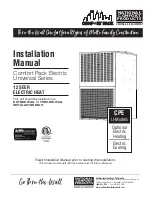
4.5.2.
Check welder is switched off “0” and that the earth clamp is away from the torch tip. Connect the welder to the mains power supply
and set the voltage switches to MIN/1. See fig.8. Set the wire speed knob to position 5 or 6. Turn on the mains power switch on the
front panel. Keeping the torch cable as straight as possible press the torch switch. The wire will feed through to the torch.
4.5.3.
When wire has fed through, switch welder off, unplug from mains.
a) Take torch in left hand, slide contact tip over the wire and screw it back into place.
b) Grasp gas cup in right hand, push onto torch head and turn clockwise only.
WARNING!
do not turn gas cup anti-clockwise, as this will damage internal spring.
c) Cut wire so that it is just protruding from the cup.
4.6.
SETTING WIRE TENSION
IMPORTANT:
You must set the correct tension, too little or too much tension will cause problematic wire feed and result in a poor
weld.
4.6.1.
For mild steel 0.6mm wire the wire tension screw must be fully tightened and undone approximately two complete turns (fig.6).
4.6.2. Correct tension between the rollers is checked by slowing down the wire between the fingers. If the pressure roller skids the tension is
correct. Try to use the lowest tension possible as too high a tension will deform the wire and may result in blowing a fuse on the printed
circuit board. When you have completed welding disconnect the unit from the mains supply and store it in a safe, dry place.
Note
: Damaged torches and cables are not covered under warranty.
4.7.
CONTROL PANEL FUNCTIONS
Refer to fig.8 below.
5. WELDING PRINCIPLES
5.1.
MIG/MAG WELDING
5.1.1.
Welding wire is automatically fed through an insulated liner to the tip of the torch. The torch consists of a switch, liner, gas hose, and
control cable. The switch activates the wire feed roller and the gas flow. Releasing the switch stops wire feed and gas flow. The weld
current is transferred to the electrode (the wire) from the contact tip at the torch end. The current to the electrode is set using the two
switches on the front of the control panel. Wire speed must be adjusted according to current output using the rotary control below the
power switches. The higher the current the faster the wire speed. A gas cup fits over the contact tip to direct gas flow towards the weld,
(See fig.9) ensuring that the arc welding process is shielded from oxidisation. The shielding gas also assists heating of the weld. The
torch is connected to the positive side of a DC rectifier, and the negative clamp is attached to the workpiece.
5.2.
PREPARATION FOR WELDING:
IMPORTANT!
BEFORE YOU COMMENCE, MAKE SURE THE MACHINE IS SWITCHED OFF AT
THE MAINS. IF WELDING A VEHICLE, DISCONNECT THE BATTERY OR FIT AN ELECTRONIC CIRCUIT PROTECTOR (AVAILABLE
FROM YOUR LOCAL SEALEY STOCKIST). ENSURE THAT YOU READ, UNDERSTAND AND APPLY THE SAFETY INSTRUCTIONS
IN SECTION 1.
5.2.1.
To ensure a complete circuit, the negative lead must be securely attached to the workpiece close to the weld area. Best connection is
obtained by grinding the point of contact on the workpiece before connecting the clamp.
5.2.2.
The weld area must be free of paint, rust, grease, etc.
5.3. GAS TYPES AND THEIR USE
5.3.1. W
elding mild steel with CO² gas is appropriate for most welding tasks where spatter and high build-up of weld do not pose a problem. To
achieve a spatter free and flat weld however, requires an Argon/
CO² mixture.
5.3.2.
To weld aluminium use:
Argon Gas
0.8mm Contact Tip
0.8mm
Aluminium Wire (MIG/2/KAL08).
5.4. THERMAL PROTECTION
Should the welder become overheated due to prolonged use beyond the stated duty cycle, the thermal protection will cause the welder to
cut out and the amber light on the front panel will illuminate. Wait for fifteen minutes for the welder to cool down at which time it
will reconnect automatically.
6. RATING PLATE (SEE ABOVE)
On the front panel of the welder is the rating plate, giving the following data:
1 - The BS/EU standard relating to the safety and construction of arc welding and
associated equipment.
2
- Inverter-transformer-rectifier symbols
3 -
Symbol indicates welding with a continuous flow of welding wire.
4 -
Symbol for Single-phase AC supply.
5 -
Rating of internal protection provided by casing.
Original Language Version
© Jack Sealey Limited
fig.8
fig.9
S
UPERMIG140.V2 Issue:1 08/07/22
























